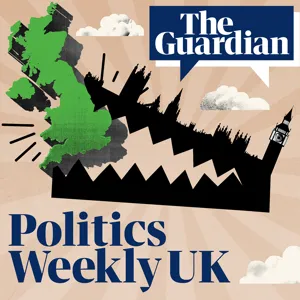Podcast Summary
Labour's Path to Power: Learning from Tony Blair's 1997 Victory: Starmer draws inspiration from Blair's successful campaign, aiming to set Labour back on a winning track after defeats, despite challenges, Blair's victory in 1997 offers a blueprint for Labour's path to power.
Keir Starmer, the current Labour Party leader, is drawing inspiration from Tony Blair's successful election campaign in 1997. Starmer, who was once an ally of Jeremy Corbyn, has been moving closer to Blair's political stance. This shift is evident in Starmer's speeches, his appearances at conferences organized by the Tony Blair Institute, and his determination to set Labour back on a winning path after four consecutive defeats. Blair's landslide victory in 1997 provides a blueprint for Labour's path to power. However, the events leading up to that victory are often mythologized and romanticized. In a series of interviews, Kieran Stacy from The Guardian spoke to people who were closest to Blair during that time to uncover the real story of 1996. That year marked a turning point in British politics, with the country feeling good about itself due to Euro 96 and the height of Britpop. But it was also a year of scandals and resignations, with the Conservative party mired in tabloid controversies. Despite the challenges, Blair and his team managed to win the election, and Starmer is hoping to replicate that success.
Fear of another defeat and the long shadow of 1992 election: The Labour Party's campaign strategy in 1997 was shaped by the fear of repeating past losses and the influence of the 1992 election, leading to a focus on reassurance and promises of radical change.
The Labour Party, despite having a large lead in the polls, was not feeling confident or prepared for the upcoming election due to past losses and the lingering fear of another defeat similar to what happened in 1992. This fear and determination to prevent a repeat of 1992 led to a focus on reassurance and promises of radical change during their campaign strategy. Peter Mandelson, who was in charge of running the 1997 campaign, acknowledged this approach but also mentioned that they were trying to balance reassurance with the promise of change. The memory of the 1992 election and the resulting Conservative victory under Margaret Thatcher cast a long shadow over the Labour Party, influencing their mindset and campaign strategies for years to come.
Blair and Miliband's approach to policy during Labour's election win: Blair and Miliband focused on modern, forward-looking policies, disposing of unpopular ones, and providing strong leadership to help Labour win the election and form a government.
During Tony Blair's leadership in the 1990s, while there was a strong desire to change the party and the country, there was also a need for reassurance and a clear policy platform. Blair and his team, including David Miliband, focused on the future, representing the many instead of the few, and providing strong leadership. They were still in the process of developing policies during this time, with Blair pushing for modern and forward-looking ideas. Miliband was tasked with disposing of policies that could lose votes and finding those that would symbolize their political project. This approach helped Labour win the general election and form a government. Some specific policies that were discarded included those related to child benefit and national insurance, which had caused issues in the past due to conflicting answers. Blair's legal training aided him in driving into policy detail to ensure they wouldn't blow up during the campaign.
1996 Labour Party Leadership Race: Internal Conflicts and External Pressures: The 1996 Labour Party Leadership Race was marked by significant internal conflicts and external pressures, particularly over minimum wage, Scottish devolution, and taxation policies.
During the 1996 Labour Party leadership race, the party was grappling with significant internal conflicts and external pressures as they formulated their policies on minimum wage, Scottish devolution, and taxation. They introduced a minimum wage and set up an independent body to decide its amount, but agreed to a referendum on Scottish devolution. These decisions were met with resistance, particularly from the unions over the minimum wage. The party also faced disagreements among its leaders, including Tony Blair and Gordon Brown, which added to the tensions. The biggest challenge, however, was the party's taxation policy, which caused much disarray and disagreement. Despite these challenges, the party continued to work towards finalizing their policies as they prepared for the campaign.
Labour Party's Shift under Tony Blair: From Socialist Principles to One-Nation Society: Tony Blair led Labour to shift from socialist policies to a one-nation society, using message discipline and tech for effective campaigning, despite criticism from within the party.
During Tony Blair's leadership of the Labour Party in the late 1990s, there was a significant shift in both policy and campaigning style. This shift was met with criticism from some within the Labour movement, who felt it amounted to selling out and abandoning socialist principles. At the same time, Labour's campaigning tactics evolved, with an emphasis on message discipline and the use of technology to respond quickly to criticism. The introduction of a new computer system, known as the Excalibur database, was intended to help Labour counteract the Conservative Party's attacks more effectively. However, the system initially faced technical challenges, which were eventually overcome. Ultimately, Blair's Labour sought to create a one-nation society and represent the interests of all people, but this vision was not without controversy.
Revolutionizing Media Relations under Tony Blair: Tony Blair's team transformed media relations by standing up to the media while courting them, notably towards Rupert Murdoch and his press, to maintain a positive image and influence coverage.
During Tony Blair's tenure as Labour Party leader, his team revolutionized the way communications were handled, making it more efficient and enabling a quick response to media queries. This approach was remembered for its combative nature towards the media, particularly towards Rupert Murdoch and his press. Blair's team aimed to neutralize the Murdoch press by courting them while also calling them out publicly when necessary. Despite some discomfort, the team believed it was necessary to keep the Murdoch press on board to avoid negative coverage. Rupert Murdoch, known for putting his own interests first, was reassured by Labour's stance on the broadcasting act, which opposed restrictions on owning both newspapers and TV stations. Although Murdoch has stepped back since then, his family still maintains control. Overall, Blair's team adopted a new approach to media relations, standing up to journalists and their editors in a way that former communications directors hadn't, while also trying to win over the Murdoch press.
Learning from Blair's example, Starmer can focus on a clear vision and unity to win back public trust: Blair's successful 1996 conference speech emphasized education, aspiration, and unity to position Labour as the winning team. Starmer can learn from this and focus on a clear, compelling vision to regain public trust and support.
For the Labour Party, led by Keir Starmer, winning the support of powerful media entities like the Murdoch empire is crucial. Blair, as a past Labour leader, understood this and used his final conference speech before an election to convey confidence and present Labour as a winning team. This speech, delivered in Blackpool in 1996, focused on three main priorities: education, aspiration, and unity. By emphasizing these points and demonstrating a strong, united front, Blair was able to position Labour as the party of aspiration and ultimately win the election. Starmer and the current Labour Party can learn from Blair's example and focus on communicating a clear, compelling vision to win back public trust and support. Additionally, the quality of speeches, especially during conference season, is essential for political success. Late nights, endless arguments, and careful planning are necessary to create a message that resonates with the public and positions the party for victory. By focusing on key priorities and demonstrating a united front, political leaders can effectively communicate their vision and win the support of the electorate.
Labour Party conference in 1997: A turning point in British politics: The 1997 Labour Party conference marked a significant turning point in British politics, with Tony Blair tapping into a sense of optimism and confidence to present Labour as the party coming home to power, despite nervousness about potential challenges and the upcoming election call.
During the 1997 Labour Party conference, there was a sense of optimism and confidence, fueled by the country's good mood after England's successful Euro football performance. Tony Blair aimed to tap into this feeling and present Labour as the party coming home to power. However, despite their confidence, the team was also nervous about potential challenges and the upcoming election call from Prime Minister John Major. This period marked a significant turning point in British politics, with Labour poised to make a comeback after years of hurt. The success of the conference, as evidenced by Blair's long-standing ovation and dance floor twirling, symbolized the potential shift in power. Yet, the team remained uncertain about what was to come, as they awaited the formal election call.





